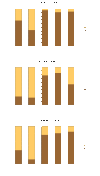An application of the edge effect in measuring accessibility to multiple food retailer types in southwestern Ontario, Canada
- PMID: 21575162
- PMCID: PMC3112377
- DOI: 10.1186/1476-072X-10-34
An application of the edge effect in measuring accessibility to multiple food retailer types in southwestern Ontario, Canada
Abstract
Background: Trends in food retailing associated with the consolidation of smaller-format retailers into fewer, larger-format supercentres have left some rural areas with fewer sources of nutritious, affordable food. Access to nutritious, affordable food is essential for good dietary habits and combating health issues such as type-2 diabetes, obesity, and cardiovascular disease. Many studies on food environments use inaccurate or incomplete methods for locating food retailers, which may be responsible for mischaracterising food deserts. This study uses databases of every residence in and every food retailer in and around Middlesex County, Ontario, Canada. Residences were geocoded to their precise address, and network analysis techniques were performed in a geographic information system (GIS) to determine distances between every residence and different types of food retailers (grocery stores, fast food, fruit and vegetable sources, grocery stores plus fruit and vegetable sources, variety stores), both when considering and neglecting facilities outside the area of study, to account for a deficiency in analysis termed the 'edge effect'.
Results: Analysis of household accessibility to food outlets by neighbourhood socioeconomic distress level indicated that residents in the most distressed neighbourhoods tended to have better accessibility to all types of food retailers. In the most distressed neighbourhoods, 79 percent of residences were within walking distance of a grocery store, compared to only 10 percent in the least distressed neighbourhoods. When the edge effect was neglected, 37 percent of distance estimates proved inaccurate. Average accessibility to all food retailer types improved dramatically when food outlets adjacent to the study area were considered, thereby controlling for the edge effect.
Conclusion: By neglecting to consider food retailers just outside study area boundaries, previous studies may significantly over-report the actual distance necessary to travel for food. Research on food access spanning large rural regions requires methods that accurately geocode residents and their food sources. By implementing methods akin to those in this paper, future research will be better able to identify areas with poor food accessibility. Improving identification of food desert communities is a first step in facilitating more effective deployment of food policies and programs in those communities.
Figures









References
-
- Lavin M. Problems and opportunities of retailing in the US "Inner City". J Retailing Cons Serv. 2000;7:47–57. doi: 10.1016/S0969-6989(99)00017-X. - DOI
-
- Wrigley N. Transforming the Corporate Landscape of US Food Retailing: Market Power, Financial Re-Engineering and Regulation. Tijdschr Econ Soc Geogr. 2001;93:62–82.
-
- Pothukuchi K. Attracting supermarkets to Inner-City Neighborhoods: Economic Development Outside the Box. Econ Dev Q. 2005;19:232–244. doi: 10.1177/0891242404273517. - DOI
-
- Kaufman PR. Rural Poor Have Less Access to Supermarkets, Large Grocery Stores. Rural Devel Perspect. 1998;13:19–26.
Publication types
MeSH terms
LinkOut - more resources
Full Text Sources
Medical

